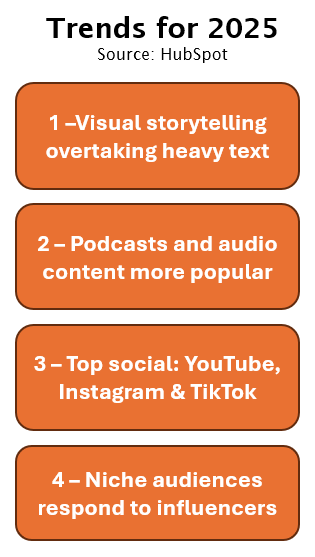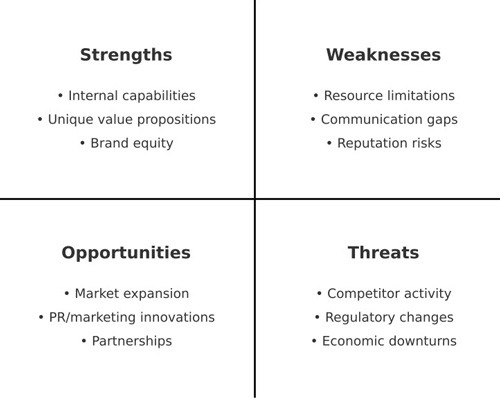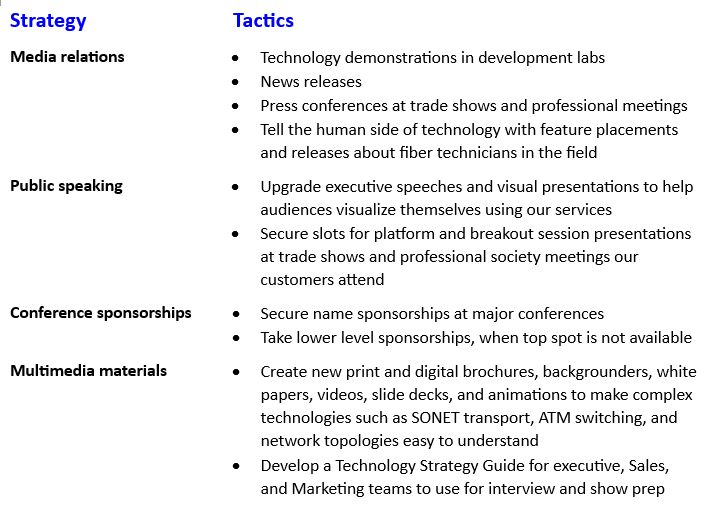Why Your Business Needs Strategic Communication Now!




“What do you mean by strategic communication and communication strategy for small businesses?” a business owner asked at a social gathering. “Sounds like just another gimmick to me.”
He explained that every week, he gets pitched by marketing "experts" promising to fix his website, flood his business with visitors, and 2x his revenue.
After working with a few, he was always disappointed. Why? All tactics, no strategy.


Strategic, Targeted Communication
This is a common pitfall for many small business owners. Marketing tactics without a communication strategy is like throwing darts blindfolded. And it produces similar results.
This guide breaks down why strategic communication is your competitive advantage and how it transforms your small business marketing.
We'll explore how a strategic communications plan brings clarity, builds trust, and ensures that every interaction with customers, employees, and the public moves your business forward.
Key Takeaways
Tactics without strategy waste time and money. A strategic communications plan ensures every message has purpose, alignment, and impact.
Strategic communication builds trust and brand reputation. It unifies your messaging across customers, employees, media, and the community.
Small businesses need strategy more than big brands. Without name recognition, clear, consistent communication is critical to stand out and grow.
Every business interaction should serve your goals. Strategic planning aligns internal and external communication with your broader business objectives.
Prepared businesses handle crises better. A crisis communications plan can protect your reputation and keep you in control when the unexpected happens.
Table of Contents
What Is Strategic Communication?
Strategic communication is a deliberate, goal-driven approach to sharing information that supports your business objectives. It’s more than just talking. It’s a process for influencing, engaging, and persuading the right people at the right time.
Strategic planning begins at the top of the organization with the company goals set by senior management. Goals are broadly stated to provide long-term direction, such as to “become the top provider in our market.”
Each department in an organization establishes specific, measurable objectives for achieving company goals, along with strategies, tactics, and messages for their department’s audiences.
Vertical and Horizontal Alignment of the Company
Strategic communication requires your messaging to be aligned vertically and horizontally within your organization.
Vertical Alignment – Communication efforts must support your overall business objectives. For example, if your goal is to expand into a new market, your communications strategy should reinforce this growth, internally with employees and externally with customers.
Horizontal Alignment – Every department—marketing, sales, customer service—needs to be on the same page. A consistent message prevents confusion and strengthens your brand identity.
For instance, marketing generates leads, while sales nurtures them. If their messaging is inconsistent, you risk losing potential customers due to mixed signals.


Why Is Strategic Communication Important?
Builds trust, and trust builds businesses. People buy from companies they know, like, and trust. Strategic communication ensures your messaging builds credibility.
Gives your brand a voice. Without a communication strategy you risk being silent and invisible in a crowded market.
Helps you control the narrative. People will talk about your business, with or without you in the discussion. A strategic communications plan helps you lead the conversation rather than react to it.
Turns customers into brand advocates. When you consistently communicate your brand's value, and customers see you walking the walk, they become your best marketing channel.
Think you don’t need a communication strategy? Think again. Think about how you’ll feel watching your competitors pop up in the top snippet and search results while your business can’t be found.
If you’re not shaping your brand’s story, someone else is. And you may not like the story they tell.
Boosting Brand and Image


Branding is about identity and positioning. Image is about trust and credibility. Both are important.
The strength of a brand is the emotional perception people have when your company name comes up. Logos and slogans attract attention and provide instant brand recognition. Customer experience determines brand loyalty.
Image is the overall perception of a company, its reputation, actions, leadership, and media portrayal. It reflects how the company is viewed by consumers, investors, employees, and other stakeholders.
Potential customers look for information about you online and talking with friends and neighbors. Strategic communication planning helps gets your messages into the conversation. Your products, services, and customer experience keep them coming back and recommending you.
Characteristics of a Strategic Communications Plan
Strategic communications plans can be as detailed or basic as you care to make them, but all share these characteristics:
Audience analysis and definition – build understanding and trust by knowing the human needs, pain points, beliefs, and how your audience communicates.
Messages designed with clear intent – knowing target audience enables you to carefully craft messages that speak to them clearly in an increasing number of channels.
Multiple communications channels – knowing your audience also reveals how to reach them, including social media, local news, email, newsletters, and more.
Calculated timing – timely delivery can be as simple as a prompt response to a social media post or as sophisticated as studying search intent of visitors to your website and then routing them to a landing page with an irresistible offer.
Measure and adjust – measure performance against plan to see what is working and what to correct.
Everyone in an organization is a communicator, whether that is in their job title or not. Sales and marketing people talk with customers and prospects.
Human Resources and senior management communicate with employees. Employees talk with their families, friends and others outside of the company.
The messages they deliver must support company goals, be based on the same information and then put into the best communications channels to reach each audience.


Elements of a Strategic Communications Plan
The following framework for strategic communications planning is a format we have developed over more than four decades of strategic communication experience. Use it as a guide but adjust as you find necessary. I will illustrate with an example from my experience.
MISSION STATEMENT
If you don’t have a mission statement, now would be a good time to create one. Why does your organization exist? One of my former employers, Finnish telecom giant Nokia, has this mission: To create technology that connects people and enriches their lives.
The vertically aligned mission statement in my department was, “Corporate Communications supports and shapes corporate image and brand through effective communication of our technology with the public and within the company.
SITUATION ANALYSIS
The situation analysis is a questioning, comprehensive look at the status of the organization, its ability to fulfill its mission, and meet its goals.
This is the foundation for the plan, so it’s worth taking the time to do it right. Bullets are fine.
Industry Outlook
Is your industry booming or shrinking? At what speed? How will new tech and laws shake things up? What do customers really think about your products and service?
In 2025, every industry—old and new—is evolving fast. Legislative, tech, and social shifts are changing the game.
Stay ahead by tracking industry trends now. AI is a game-changer, leveling the playing field for small businesses by automating tasks and boosting productivity.
Business Environment
Your business environment is shaped by two things: your community and your company culture. A strong, positive workplace boosts productivity, efficiency, and profits.
Hiring is tough, no matter what your size. In small towns, a limited talent pool makes it even harder, and external forces can shape both employee and customer expectations.
Your business doesn’t operate in a bubble. Suppliers, partners, and the public all affect your success. Add in taxes, local economics, and competition, and you’ve got a business environment that demands strategy.
External Communications Environment


External media is everywhere—local, national, global, print, broadcast, online, trade publications, and social media. That’s a ton of exposure – and opportunity!
Journalists are stretched thin, so respect their time. Understand what matters to their audience and how shrinking newsroom staffs affect their work.
You don’t control the media conversation, but you can shape the story by influencing the tone and direction. Having strategic messaging in place helps you respond quickly.
Give consumers what they want. A study by HubSpot, a marketing software company, found significant shifts in marketing trends for 2025, summarized at right.
Internal Communications Environment
How does info flow inside your company? Is it word of mouth, bulletin boards, newsletters, or team meetings? More importantly, do employees feel heard?
Do your employees feel secure in their jobs? Would they refer a friend? Is communication a one-way street, or do you actively seek their input?
Improve internal communication. Keep employees in the loop and make sure they hear key messages before the public does.
Your employees are your most powerful brand ambassadors. Keep them informed, and they’ll represent your business better than any ad campaign.
A 2025 Cision study found that employees – not influencers, execs, or consumers – are the top drivers of public opinion. When employees believe in your company, the world does too.
Competitors
Know your competition inside and out—direct, indirect, and potential. Who are they? What are their strengths, weaknesses, market share, and strategies? Who are they targeting? What do they nail, and where do they fall short? Spot the gaps and add value where they can’t.
Direct Competitors: Businesses offering similar products or services to the same target market.
Indirect Competitors: Businesses offering alternative solutions to the same customer needs.
Potential Competitors: Businesses that could potentially enter the market.
SWOT Analysis
Armed with facts you’ve gathered in your analysis, you’re ready to give it perspective with a SWOT analysis chart.
This chart shows just a few things you might consider. You may have ten or twelve items to consider, but two or three should be a bare minimum.


BUSINESS GOALS AND OBJECTIVES
This example shows how broadly stated goals lay the foundation for specific, measurable objectives at business unit level.
When I worked at telecom giant Sprint (now merged with T-Mobile) we were in fierce competition with AT&T and MCI (now merged with Verizon).
“Improve customer satisfaction” was one of five overarching goals laid out by senior management for the coming year. My Network/IT business unit of 7,000 network engineers and IT professionals ran the long-distance network.
Our business unit goal was to “Improve customer satisfaction through enhanced service assurance and service delivery.”
The Network/IT objective was: ”Evolve our technology infrastructure …through SONET installation, switch consolidation, migration to an integrated service platform, and evolution of the order entry system to point-of sale laptop computers.”


That was specific and measurable in four different areas. (1) SONET enabled us to push more bits of information through our fiber optic network in less time. (2) New switching technology let us route traffic faster while using fewer switches.
Those technologies were part of our strategy to (3) integrate voice, data, and video over a single broadband network – something we take for granted today, but which was a big advancement in the 1990s.
This enabled our customers to (4) process sales at retail locations using laptop computers – another tech miracle at that time.
COMMUNICATIONS CHALLENGES
Change – Laws change, new technology platforms emerge, and customers become more sophisticated consumers who demand more from businesses.
Growth – New employees require extra communications effort to assimilate into the culture. The faster the growth, the bigger the challenge. You may need special or localized information for different work groups.
New services/products – Adding new products and services, requires repeated messaging with all parts of the company – sales, marketing, customer service, and any other customer touch points.
Feedback – Make certain employees, customers and suppliers have the means to be heard. They will have valuable input, so remove communications barriers.
Negative perceptions – Misinformation and disinformation are the norm for social media. Make sure all your constituencies have the correct information.
COMMUNICATIONS INTENT
This is a key point in any communications plan – what action will result if everything goes right? Communications intent usually pertains to some achievement or recognition for the company.
You may want to survey your audiences to establish baseline data. Examples of intent include:
Brand awareness – Become a household name in the community.
Brand preference – Be the go-to provider in your market.
Change management – Get employee buy-in on a new benefits plan.
Community relations – Be recognized as a good neighbor.
Customer service – Be recognized for sensational customer service.
COMMUNICATIONS OBJECTIVES
Each communications objective must line up vertically with overall business objectives. In the example from Sprint we used previously, we had these:
Corporate Goal – Improve customer satisfaction.
Network/IT Business Unit Goal – Improve customer satisfaction through enhanced service assurance and service delivery.
Network/IT Business Unit Objective – Evolve Sprint technology infrastructure …through SONET installation, switch consolidation, migration to an integrated service platform, and evolution of the order entry system to point-of sale laptop computers.
Here’s how the communications objective lined up with those.


Network/IT Communications Objective – Continue to build Sprint’s reputation as a technology leader by holding at least three ‘Information Superhighway’ technology demonstrations for news media at Sprint Labs Silicon Valley facilities, with each demonstration to result in at least six placements in trade and general news publications or one major television story.
These objectives were measured by completion of the stated number of events and “did we get the news coverage?”
We used a third-party news content analysis service to measure results through human and computer-assisted analysis. The company evaluated message treatment, favorability, share of voice, volume, and other measures.
TARGET AUDIENCES
Most customers won’t be interested in what you have to say – unless they’re in the market for what you offer. Craft your messages to appeal to the people you want to reach.
You always have more than one audience. Consider employees your Number 1 audience. They need to know everything you tell people outside the company, as well as details specific to their jobs.
Our target audiences for Communications at Sprint were employees, B2B and B2C customers and prospects, technology partners/providers, community leaders, news media, industry analysts, and the public at large.
KEY MESSAGES
Continuing with the Sprint example, we had five senior management and business unit objectives and eight highly refined key messages in our message bank.
Those messages served to guide all discussions with our target audiences. Word length will vary, but messages need to be specific and substantive.
The Network/IT business unit key message #1 of the above objective was: “As customers drive mission-critical applications across distributed computer networks, downtime is unthinkable. Only Sprint’s SONET four-fiber, bi-directional, line-switched ring architecture will provide service restoral in milliseconds, not minutes, as offered by AT&T and MCI. Not all SONET is alike!”
The Network/IT business unit key message #2: “The convergence of telecommunication and information technology demands a unified approach to managing voice and data in all industries. Sprint’s integrated Network/IT approach is a model for our customers and other businesses, which historically have maintained separate telecom and data departments.”
This was a major change in thinking about telecom and data networks. Our job was to prove that we had the technology to make it work for customers, which we did.
We did one SONET demonstration at an active network switch center in Chicago using live data. To make it unforgettable, we laid a fiber optic cable on a wooden butcherblock table and had the vice president in charge of Network Services whack it with a shiny fire ax.
When service was restored in about 50 milliseconds (less time than it takes to blink your eye), one major bank customer said, “with that kind of service restoration, we won’t need a backup network supplier.”
Bingo! Our relationship with that customer (and many others) was cemented by that demonstration. We made a video of the demonstration and sent copies to all our commercial customers and prospects, and the news media.
COMMUNICATIONS STRATEGIES AND TACTICS
A strategy is a way or means to reach objectives and a tactic is a specific action you will take to implement a strategy. Strategies are the how, tactics provide the what, when, and who.
Here is a sampling of strategies and tactics we used in the Sprint example.


METRICS
The real test is measuring results against your plan. If you hit every goal, you may have been aiming too low. Aim high, learn what didn’t work and then make corrections.
Automation gives you real-time performance data and insights that were impossible just a few years ago, but don’t overcomplicate it. You don’t need a dozen tools to track progress.
Most small businesses get huge value from simple, affordable tools. Let’s break down the key metrics that matter.
Awareness & Reach – Track media mentions across news, blogs, and analyst reports. More mentions = more visibility. Compare with competitors to gauge your share of voice.
Check website traffic sources—are people finding you through blog posts, news releases, or social media?
Engagement – Quality beats quantity. Are visitors sticking around your site or bouncing in seconds? Social media engagement? Track likes, shares, comments, and new followers.
Email marketing? Monitor open rates and click-throughs. Use unique landing pages to track exactly where traffic is coming from.
Message Penetration & Perception – Are journalists and followers picking up your key messages? Is sentiment positive, negative, or neutral? AI can help analyze the tone.
Take it a step further with DIY surveys to measure brand awareness and sentiment. Check out Zapier’s 9 Best Survey Apps for 2025 to find the right tool.
Crisis Communications Plan
Picture this:
Your store is robbed. Employees and customers are shot.
A fired employee starts a viral smear campaign against you.
Hackers expose your customers’ personal and financial data.
How many times have you heard, “I never thought it could happen here”?
Well, think again.
A crisis can hit any business, anywhere, at any time. If you’re not prepared, the fallout can destroy your brand, reputation, market value, and trust with employees, suppliers, and customers.
No one plans to have a crisis, but they’re not always preventable. Your response is 100% in your hands and can be planned.
The Golden Rule of Crisis Management
Tell it early, tell it all, tell it yourself.” Lanny Davis
Davis, a U.S. presidential advisor, knows how to manage crises. His advice is simple: Own the narrative. Speak first and fully without delay.
When you control the story, you help control the damage. Transparency builds trust, stops rumors, and shifts the focus from blame to solutions. The faster you get the facts out, the sooner you can fix the problem.


In a crisis, silence isn’t an option. If you don’t tell the story, someone else will. This is how misinformation and conspiracy theories start.
A Strategic Approach for Crisis Response
A crisis is unpredictable, but your response shouldn’t be. The key to managing chaos? A solid plan.
Crisis planning follows the same playbook as any strategic effort—clear goals, strategies, audiences, key messages, and success metrics. But here’s what makes it different:
Crisis Communications Team – Assemble a core team: Communications, CEO, Legal, HR, Marketing/Sales, and any impacted departments. Designate primary and backup spokespersons.
Crisis Team Training – Run drills at least twice a year. Simulate real scenarios so your team knows exactly what to do when the heat is on.
Crisis Type Matters – A product recall isn’t the same as a data breach or an executive scandal. Assess the risk level fast so your response fits the situation.
Crisis Command Center – Small businesses – use any available room. Bigger companies should dedicate a space with telecom and data access for seamless communication.
Contact Database – Create a list of individuals, departments, and agencies and full contact information so you can reach them immediately, under pressure.
News Templates – Create fill-in-the-blanks press releases, social media updates, and internal messages that address the who, what, when, where, why, and how. This saves time and helps prevent overlooking key points.
Response Procedures – The first 24 hours you will be busy getting the facts, assessing the situation, and making initial contacts.
The next 48 hours adjust messaging and keep stakeholders updated. After that, focus on longer-term fixes and reputation management.
Hard Copy Crisis Plan – Digital is great—until the power’s out. Print copies for all crisis team members and update them quarterly.
Frequently Asked Questions
1. Isn’t strategic communication just fancy marketing speak?
No. Strategic communication isn’t just about selling – it’s about influencing perception, building trust, and ensuring your business has a clear, unified voice. Marketing is one part of it, but strategic communication also includes employee communication, public relations, advertising, and customer care. It’s speaking with one voice to all stakeholders.
2. My business is too small for a strategic communications plan. Isn’t this just for big corporations?
If anything, small businesses need strategic communication more than large corporations. Big brands already have recognition, but small businesses must work harder to get noticed and earn trust. Whether you’re a one-person operation or a growing team, having a clear, strategic approach to communication helps you attract the right customers, manage your reputation, and stand out in your industry.
3. Can’t I just rely on social media and word-of-mouth marketing?
Social media and word-of-mouth are powerful, but they’re unpredictable and can’t be your only strategy. What happens when an unhappy customer posts a negative review? Remember, you don’t own or control the content you put on social media; it is Shared media. You need Earned media (third-party coverage), Owned (website, blog), and Paid (advertising).
4. What’s the risk if I don’t have a strategic communication plan?
Inconsistent messaging among your audiences, which leads to confusion. A well-designed strategic communications plan keeps your messages consistent, no matter what department does the talking and keeps everyone working toward achieving the company’s goals and objectives.
5. Isn’t this just a lot of unnecessary planning? I need action, not strategy.
Action without strategy is like sailing without a chart – no reference points to know where you are or where you’re going. Strategy shows the way, point by point, toward your objective. You’re not just busy, you’re moving toward a goal. A well-crafted communication plan saves time, money, and effort by focusing on what actually moves the needle.
6. If my product or service is good enough, won’t people just find me?
Wishful thinking. The best product or service in the world means nothing if no one knows about it. People are bombarded with messages every day—if you don’t actively shape how they see your brand, someone else (your competitors, dissatisfied customers, or a dismissed employee) will do it for you.
7. How soon can I expect results from strategic communication?
That depends on your approach. An online news story or a popular social media post can show results quickly, although building the contacts to get the story out takes some time. Even with a fast start, building brand and image takes message consistency over time. Companies that use strategic communications well invest in it as the best way to get long-term success.
8. What’s the biggest mistake small businesses make with communication?
Thinking communication is just a marketing function. Communication impacts every area of your business – your team, your customers, your partnerships, and your reputation. The biggest mistake is treating business communication as an afterthought instead of a business-critical strategy.
Conclusion
Strategic communication isn’t just a buzzword – it’s the backbone of a successful business. Without it, you’re leaving your brand, reputation, and customer relationships to chance.
A well-thought-out communication strategy aligns your messaging with business goals, ensuring that every interaction, whether with customers, employees, or the media, reinforces your brand’s credibility and value.
To bring this full circle, tactics without strategy are like throwing darts blindfolded. You might hit the target, but with a clear strategy, you’re aiming with precision.
From brand positioning to crisis response, strategic communication gives you the control and foresight needed to stand out in a crowded marketplace.
Don’t wait for miscommunication to cost you customers. Start building a strategy that tells your story, earns trust, and drives growth. Businesses that communicate effectively aren’t just heard and seen; they’re remembered.
Strategic Planning Consultant/Advisor
Learn more: info@bowmanpr.com
Phone: +1-817-291-9182
Dallas/Fort Worth, Texas
© 2025. All rights reserved, J. R. Bowman & Associates, LLC.
